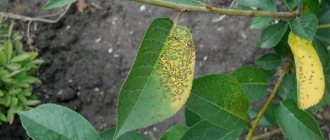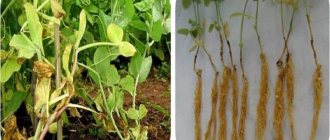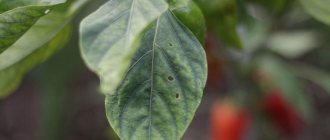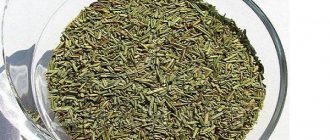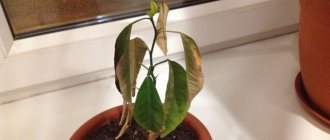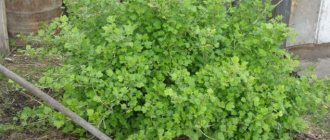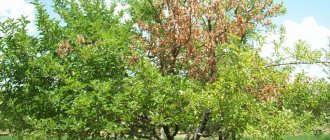Causes of citrus diseases
The appearance of diseases on lemon is a frequent process, especially if the citrus plant is grown indoors. Such vegetation has weak immunity and negatively tolerates any temperature changes in the room.
At home, citrus diseases can occur for the following reasons:
- weak immunity that occurs as a result of improper crop care;
- previous illnesses;
- low-quality indoor lemon seedling;
- introduction of pests from the street;
- use of contaminated objects during crop care;
- introduction of bacteria during spraying or airing of lemon in the summer;
- lack of nutrients in the soil.
Often the cause of lemon diseases is improperly selected soil, which does not allow air to pass through well and causes rot on the roots. Another common reason for the introduction of fungal spores into citrus crops is placing the crop on balconies in the summer. Infection can occur due to wind or rain.
The tips of the lemon leaves dry out
Description of the reasons why leaf tips dry out:
- dry air;
- low or high room temperature;
- using tap water for irrigation;
- too dense soil in the pot;
- waterlogged or overdried soil.
If the end of the leaf dries out due to dry air, then you need to increase the humidity in the room. You can place a cup with wet expanded clay next to the citrus tree, regularly spray the tree and wipe the leaves, or buy an air humidifier for your home.
Note! Drying of the tips is also accompanied by yellowing of the foliage.
It is not recommended to use tap water for irrigation. It contains a large amount of fluorine and chlorine, so it is too hard. It is better to use purchased and rain water or melted snow. You can also boil and then settle tap water. Before watering, add a few drops of lemon juice or a little citric acid to soften it.
If the soil in the pot is compacted, you need to replant. In order for the lemon to grow normally, transplants are carried out once every 2 years. If necessary, lemon can be replanted every year. Regular transplants will help revive the citrus.
Also, the edges may dry out due to improper watering and temperature disturbances. In summer, the soil should not be over-moistened, and in winter, it should not be allowed to dry out.
Fungal and infectious diseases: signs and treatment
The appearance of a fungal infection in a short time can lead to the death of the plant. Therefore, it is necessary to promptly identify the first symptoms and choose the necessary treatment method. A fungal infection can be quickly eliminated in the first stages of its appearance; later, when the disease has developed, it is necessary to prune the bush, otherwise the plant dies.
Melseko's disease
The first symptoms of the disease are the withering of young shoots, which gradually dry out completely. After the leaves fall, the cut area turns dark red. The fungus can quickly spread to healthy areas of the plant and also infect nearby crops. The problem is caused by a lack of sunlight, which results in the formation of fungal strains. For treatment, it is necessary to trim off the affected areas. Place the lemon on the sunny side.
Important. There are no drugs against Melseco, so it is necessary to carry out regular inspections of the plant and promptly eliminate the first signs of the disease.
Powdery mildew
When this disease occurs, light-colored spots appear on the leaves. Gradually the leaf turns yellow and dies. This type of disease occurs with excessive air humidity and frequent watering. It can affect not only leaves, but also young shoots. For control, spraying with Bordeaux mixture 1% is used.
Gommosis (gum discharge)
The disease is manifested by the presence of red stripes on leaves and young shoots. With severe infection by a fungal disease, the bark on the trunk begins to die and the leaves fall off. The disease reduces yield, the crop does not bloom and may die in a short time.
To eliminate the problem, it is necessary to prune the infected areas. The cut areas are treated with manganese solution and garden varnish. It is also necessary to spray the lemon with a 3% solution of copper sulfate.
Root rot
The first symptoms of the disease are shedding of leaves and lethargy of shoots. When examining the roots, you can notice black dots that gradually increase in size. To treat the disease, it is necessary to prune the affected areas and transplant the crop to a new place of growth.
Sooty fungus (niello)
Lemon becomes covered with a specific dark coating. Plaque most often appears on the leaves and has a viscous consistency. For treatment, it is necessary to treat the leaves with a light solution of manganese and wash off the remaining fungus with running water. After which the pot is placed in a sunny place.
Important.
Plaque on lemon leaves often causes an allergic reaction. Young children are especially susceptible to this process. Therefore, if there is a disease on the lemon, the pot with the citrus tree should be moved to an isolated room. See also
How to get rid of scale insects on lemon, control measures and the best means for treatment
Read
Scab (citrus warts)
The disease often appears on citrus fruits, affecting leaves and shoots; during fruit formation, warts can be found on green lemons. Fruits affected by scab rot and fall off. For treatment, it is necessary to treat the bush with a 2% solution of copper sulfate. The affected areas must be trimmed with sharp pruning shears and treated with Bordeaux mixture.
Anthracnose
This type of disease occurs when the crop is not properly cared for. The cause of fungus is high humidity in the room. Brown spots appear on the leaves and shoots. The spots gradually increase in size. To eliminate the problem, you need to treat the lemon with Bordeaux mixture. If such a procedure does not give the necessary results, it is necessary to treat the culture with special drugs against fungal diseases.
Rust
The first signs of the disease are brown spots on the leaves. Gradually the spots increase in size. Yellow spots appear on the leaves. Young shoots wither and turn yellow. The lemon weakens and practically does not bloom. Drying of shoots and leaves may occur. In a short time, rust can destroy an adult crop and lead to its complete drying out. You can remove the fungal disease using the drug “Strobilin” or Bordeaux mixture.
Yellow spots on lemon leaves - what to do
Yellow spots are a common symptom of most diseases. In order to accurately determine the cause of their appearance, you need to pay attention to other signs.
Anthurium has brown spots on the leaves - causes and treatment
Why do indoor lemon leaves turn yellow?
- hypothermia;
- lack of magnesium or zinc;
- fungal, bacterial and viral diseases (cancer, root rot);
- appearance of insects.
Yellow spots appear due to scale insects. The fight against this pest has been described in another section.
The second factor is hypothermia. Lemon is a very heat-loving plant and a sharp drop in temperature never goes away without leaving a trace. If the temperature in the room drops below +14 degrees, you need to either turn on the heater or move the citrus to a warmer place.
Important! Lemon does not tolerate frequent moving of the pot. The tree may even die from this.
You can determine which mineral the citrus plant lacks by the location of the spots. If the tips dry out, it means there is a deficiency of magnesium in the soil. If yellow spots appear near the veins, there is not enough zinc in the soil.
Scab on lemon
Diseases that cause yellow spots:
- Cancer. An incurable disease that causes dark brown spots with a yellow border. In this case, the plant should be thrown out immediately so that other crops do not get cancer.
- Root rot. You need to cut off all affected areas, then transplant the citrus into another pot with new soil. After this, add mineral fertilizers.
- Scab. Small pink-yellow or brown warts appear on the underside of the leaf. The affected areas of the lemon are cut off. The plant itself is sprayed with copper oxychloride or copper sulfate.
Viral tree lesions
A citrus tree that is affected by a viral type of disease is difficult to treat. Such diseases lead to a lack of harvest and withering of the crop in a short period. The virus is transmitted during watering or by the wind. Also, the cause of infection with the virus can be soil and tools that have not been previously treated with a special disinfectant.
Citrus cancer
Symptoms of the disease are dark spots on the leaves. Lemons lose their shape and are often small in size. The virus quickly spreads throughout the plant, causing the leaves to fall off. At the first symptoms of the disease, it is necessary to remove dry shoots and spray with liquid copper.
Important. If there is a large accumulation of cancer symptoms, treatment does not produce results, so the plant must be removed. Otherwise, the infection will spread to other vegetation.
Leaf mosaic
The disease rarely appears on lemons. The virus manifests itself by the presence of large numbers of spots on the leaves. The shoots become pale and lose their color.
The virus spreads quickly throughout the culture and cannot be treated.
Tristeza
This type of virus occurs rarely. The lemon loses all its foliage, and the shoots gradually begin to die. The virus cannot be completely cured, so if symptoms of the disease occur, the plant must be removed. Most often, the cause of the disease is poor-quality planting material.
Pollen has no place in the house
Pollen provokes seasonal AR or hay fever. In order to take timely measures, you need to know the flowering schedule of the plants to which you are allergic. Here are some tips for avoiding pollen from the English National Health System (NHS) and the Russian Journal of Allergology during the blooming of "dangerous" plants:
- do not dry washed items outside;
- keep windows and doors closed;
- if possible, use air conditioners with special filters;
- To protect your eyes outdoors, glasses with tight-fitting frames will help;
- after returning from the street, you need to change clothes and take a shower;
- walk around parks and fields.
Insects and pests: symptoms and methods of destruction
Most often, diseases on citrus trees occur as a result of infestation by harmful insects. Parasites not only destroy the integrity of leaves and shoots, but also transmit strains of fungi. Pests destroy the citrus plant and lead to a decrease in immunity, as a result of which the lemon cannot fight diseases on its own.
Sciarids (midges)
Small midges accumulate on lemons and feed on the juice of the crop. It is difficult to notice insects; they are small in size and fit tightly on the shoots. The first symptoms are the presence of spots and damage to the leaves. To eliminate this, special chemicals are used to treat the crop.
Springtails or springtails
Such pests appear as a result of the accumulation of moisture in the soil. Externally, insects are small in size. Insect larvae are light in color and move throughout the lemon. The first symptoms of pests are the presence of damage and compaction on the crop. Insects move around the crop by jumping. To remove pests, the lemon is transplanted into new soil and the roots of the crop are dried.
It is also recommended to treat the root part with charcoal or ash.
Shields
The pest appears on lemon most often when the seedling is infected. Scale insect larvae move around the plant and feed on sap. After the insect matures, it sticks to the leaves and forms a kind of seal. The insect lays eggs in its shell. Parasites can affect not only leaves, but also young shoots. The fight against scale insects is carried out using garlic water. To do this, you need to infuse 100 grams of garlic in a liter of water and spray the plant.
Whitefly
The small butterfly has light-colored wings. The insect does not harm citrus fruits, but after laying eggs, larvae appear that destroy the lemon. The larvae also secrete a specific liquid, which provokes the appearance of fungus on the leaves. For treatment, it is necessary to spray the lemon with drugs such as Karbofos and Decis. Larvae infesting lemons can be removed using onion or garlic water.
See also
Description of caring for variegated variegated mandarin of the Unshiu species at home
Read
Aphid
Aphid attacks are common in citrus crops. Despite the fact that the plant contains large quantities of essential oils, the pest can harm the lemon in a short time. Aphids are small in size and most often accumulate on leaves and shoots. To treat aphids, it is necessary to treat the plant with a solution of laundry soap. You can also treat lemon with a solution of copper sulfate and wood ash.
Mealybug
The appearance of mealybugs does not go unnoticed. The first symptoms of the pest are the presence of a white coating on the leaves. Light-colored small parasites stick to the leaves and suck out the juice. The pest affects not only foliage, but also shoots and buds. Lemon reduces its development and productivity.
The cause of the pest is moist air, which interferes with the penetration of air into the leaves. To get rid of the parasite, you need to dry the soil in the pot and ventilate the room. If there is a large concentration of the pest, it is necessary to use drugs such as Intavir and Decis.
If the number of parasites is small, you can use a solution of laundry soap to wipe the leaves and shoots. To prevent the appearance of parasites, it is necessary to treat the crop with an infusion of tobacco dust once a month.
Thrips
The first signs that thrips have appeared on lemon are weakness of the crop and curling of the leaves into a tube. The parasite is small in size and often goes unnoticed when it appears. Harm is caused not only by small insects, but also by larvae. Insects can multiply rapidly in a short time.
The parasite feeds on the sap of the crop. After the parasite appears on the leaves, you can notice the presence of light stripes that remain after they move. When there is a large concentration of the pest, lemon leaves lose their color and fall off. Young shoots wither and dry out. The insect can quickly move through the plant and infect neighboring crops.
To remove the pest, it is necessary to treat the lemon with ash. To do this, pour 200 grams of the substance into a liter of water. After the ash has dissolved, the citrus plant is treated. You can also use special preparations that eliminate the pest in a short time.
Spider mite
The pest often appears on mature lemons. The first signs of infection are a sticky coating on the shoots and the appearance of cobwebs. The mite quickly spreads to healthy areas and attaches itself to leaves. To combat the parasite, it is necessary to spray with a 1% boric acid solution. To obtain results, spraying must be done every 3 days.
Important. Spider mites can hide in leaf layers and go undetected. To identify the pest, you must carefully examine the inside of the leaf.
Most often, small dark-colored compactions are noticeable on leaves when infected.
Sticky coating on lemon leaves
Gooseberry diseases and their treatment
Sticky plaque is not always a sign of disease or a pest. It is quite possible that plaque is released due to improper watering. In the natural environment, a sticky coating appears to attract ants, which in turn destroy pests on the tree. If a sticky coating appears on your homemade citrus fruits, don’t panic right away.
Pests of indoor lemons that cause a sticky coating:
- scale insect;
- aphid.
The scale insect is dangerous because if it is not noticed in time, the citrus will die. If a sticky coating appears on the tree, the plant begins to dry out, and spots appear on the foliage and stems, then it is a scale insect. Treatment with Fitoverm and Aktara helps against the pest. To completely destroy the pest, 3-4 treatments will be required at intervals of 2 weeks.
Aphids on citrus
The second cause of sticky plaque is aphids. Detecting a pest is not at all difficult. These are small green bugs that can be seen both on the foliage and on the rest of the plant. To destroy the pest, citrus is sprayed with a solution of laundry soap every day for a week. You can also use garlic water. You need to spray every day for 5 days.
Prevention
Treatment of diseases and elimination of pests is a complex process if such a problem arises. It is much more effective to take measures that will prevent the problem from occurring and keep the lemon healthy. For prevention, the following features must be observed:
- Inspect the crop daily for damage.
- The lemon should be placed on the sunny side. The air in the room should have moderate humidity.
- Timely watering and fertilization. Excessive watering negatively affects the health of the crop.
- If pests appear on the lemon, it is necessary to temporarily isolate the crop from other vegetation.
- In the spring, carry out preventive treatment with Bordeaux mixture of citrus trees.
- Once a week it is necessary to spray the plant with cool water.
- Once a month, the leaves of the crop are treated with a solution of laundry soap.
- When replanting a lemon, it is necessary to remove damaged roots and treat the pot with a disinfectant.
Often, special preparations are used for prevention, which are biological types and do not affect the growth of lemon. A properly selected product can prevent the occurrence of diseases and increase productivity.
Why does a lemon get sick?
This exotic plant is affected by diseases and pests in the following cases:
- in the process of grafting with a diseased cutting;
- improper care: planting in contaminated soil, too frequent or infrequent watering, insufficient lighting, improper pruning or insufficient soil fertilization;
- the plant did not have time to get stronger after the previous disease;
- infection of healthy domestic specimens by street ones;
- entry of bacteria, viruses and fungi into the room during ventilation;
- making mistakes in the process of propagation, planting and transplanting.
Scale insect and false scale insect
Scale insects as a pest of young lemons.
Photo: GardenWeb Scale insects are small sucking pests of lemons that resemble small turtles, up to 5 mm in size. Larvae and adult insects are harmful. Scale insect larvae are mobile and can migrate from plant to plant, even along a windowsill.
Having reached the plant, the scale insect larvae attach to it and begin to grow, secreting liquid from the glands, which forms a shield on the insect’s body that protects the scale insect from chemicals. Adult scale insects are motionless and difficult to separate from the plant. During the year, females give birth to 2-3 generations of larvae.
Scale insects settle on lemon leaves, along the veins at the top and bottom of the leaf, and on the fruit. The leaves become sticky, turn yellow and wither.
In the initial stage, scale insects are almost transparent, whitish in color, barely noticeable. Adult insects are noticeable after the growth of the scutellum: light gray round ones - scale insects and brown oval ones - false scale insects. Plants weaken and yields decrease.
How to deal with scale insects? The easiest way to get rid of scale insects is at the initial stage of colonization of the plant - they are inactive and do not bite. Collect a small number of scale insects by hand, and then wipe the leaves and branches with a cotton swab or toothbrush dipped in a solution of laundry soap or alcohol.
Folk remedies for scale insects:
- Water-oil emulsion. This is a more concentrated version of a similar emulsion to combat spider mites. 1 teaspoon of machine oil, 2 tablespoons of washing powder and 40 g of laundry soap are thoroughly mixed in a glass of warm water. The prepared emulsion is applied to all leaves and branches of the plant using a cotton swab. It is necessary to ensure that the emulsion does not get into the soil; to avoid this, cover it with plastic film before starting treatment. After 3.5-4 hours, the plants are thoroughly washed with clean water. The treatment is repeated at least 3 times, the break between treatments is 5-6 days.
- Garlic porridge. Dilute grated garlic and laundry soap with water in a ratio of 1:1:3. Using a toothbrush, apply the resulting pulp to all parts of the plant (leaves, branches, trunk). After about an hour, the pulp is washed off the plant with water.
- Decoction of bitter capsicum. Pour crushed pepper pods (100 g fresh or 10 g dry) into 1 liter of water, boil for 30 minutes and leave for 2 days. Before use, 1 tablespoon of concentrate is diluted with 1 liter of water, adding 1 tablespoon of grated laundry soap to the solution. After 2 hours, the plant is washed with water. Spraying is carried out every 2 weeks until the pests disappear.
Attention: A decoction of hot pepper can be used against aphids and spider mites
Varieties of homemade lemons
Some varieties of lemons can only be grown in the southern regions , others like lower temperatures and take root only in the northern regions . Lemons are divided into the following varieties:
- Ural lemon is an unpretentious plant that grows well both in hot weather and at low temperatures. With proper care, yields up to 12 kg of harvest per year
- Pavlovsk lemon is a lemon variety that was one of the first to be grown indoors. The plant grows best in dark places, but despite this, it blooms all year round. The harvest from this type of lemon varies from 10 to 40 kg per year
- Lemons without a single thorn are called Maykop and Genoa. The first variety of lemon has very thin branches and a dark, lush crown. The harvest per year reaches 30 kg. The second is noted as a low-growing plant and produces a harvest only from the fourth year of life. The amount of harvest initially does not exceed 8 kg in the first years and up to 40 kg in the subsequent period
- Ponderosa lemon is a citrus fruit variety whose fruits reach 1 kg in weight. But due to the fact that the fruits are large, the harvest does not exceed 5 pieces per year
- Yubileiny , also boasts large fruits - they can reach 600 grams in weight
- A hybrid variety is a type of lemon called Chinese - a mixture of lemon and orange. A rather capricious plant that requires careful care. Productivity is low - up to 3 kg annually
Chinese lemon
There are a huge number of lemon varieties that you can grow at home. They are all different - some like heat and sun, others like partial shade and coolness. If you decide to plant a lemon in a pot at home, be sure to check what temperature and light conditions are suitable for this variety.
How to trim indoor lemon?
In order for the lemon tree to bear fruit well and have the correct shape, you need to regularly prune and turn the tree on the windowsill relative to the sun every two weeks. You can straighten the trunk by tying the branches with copper wire. This way the branches will grow in the right direction.
If the lemon already has fruits, then when ripe, you should cut off not only the fruit, but also the 5-7 cm long branch on which the crop grew. And within a week, new shoots will grow at the cut site.
To obtain a fragrant tree with fruits, it is necessary to prune it.
If you have too many fruits on the tree, then you need to adjust their number at the rate of 1 fruit per 10-12 leaves. All other lemons must be removed so that the plant does not have a very hard time. Give your plant the right shape so that it bears fruit well and looks healthy.
Lemon propagation at home
Lemon can be propagated using seeds or cuttings . Each of these methods has negative and positive sides:
- When propagated by seeds, the tree is more powerful compared to a lemon obtained from cuttings
- When propagated by seeds, fruits appear only after 7 years ; from cuttings, lemons will appear within 3 years
Lemon can be propagated by seeds or cuttings
. Let's take a closer look at these types of propagation. After eating the lemon, plant the seed in a pot with a mixture of soil , humus and sand to a depth of no more than 2 cm, and spray the soil. When propagating by seed, the first shoots from the seeds appear in a maximum of a month. Over time, the plant grows long, thin branches that need to be trimmed.
Propagation by cuttings is a faster way to get a beautiful tree. In a pot with drainage, you need to plant 5 cuttings from a healthy lemon with cuts and cover with a jar. After three weeks, the first shoots will appear. It is worth replanting such a lemon into a pot 2 months after the shoots appear.
When propagating lemons, it is necessary to fertilize the plant with manure or a special mixture from stores once every few months . Fruits after this propagation method, depending on the variety, may appear as early as next year.
Lemons grown from seeds will not bear fruit immediately - only after 7-8 years.
Don’t be lazy to use at least the first method, because it’s not at all difficult to stick a lemon seed into the pot. But the beautiful green tree that will grow from such a seed will delight the eye every day.
How to graft a lemon?
A lemon grown from a seed will most likely not bear fruit if it is not grafted. In order to get a citrus harvest you need:
- Cut off the scion just before grafting. It is better to do this between April and August
- Trim the scion to 6cm and remove all but the top leaves - leave about 4 leaves
- Make a cut from the top about 1 cm long and treat the cut area with garden varnish.
- Cut off half of each leaf on the scion, tie it with tape to the rootstock, and place it under a glass container or large plastic bottle.
- After 2 weeks , check how the grafting has started - whether the cut leaves are easily separated
In order for a tree to bear fruit, it must be properly grafted.
If the leaves begin to fall off over time, then this is a clear sign that the grafting of the tree was successful and you can slightly loosen the tape with which you tied the scion and rootstock.
Typically, such methods of lemon grafting are successful and within a year after such a procedure you will see the first, unusually smelling white flowers, from which a delicious citrus fruit will eventually grow.


